2004 MITSUBISHI ENDEAVOR cover
[x] Cancel search: coverPage 4 of 3870
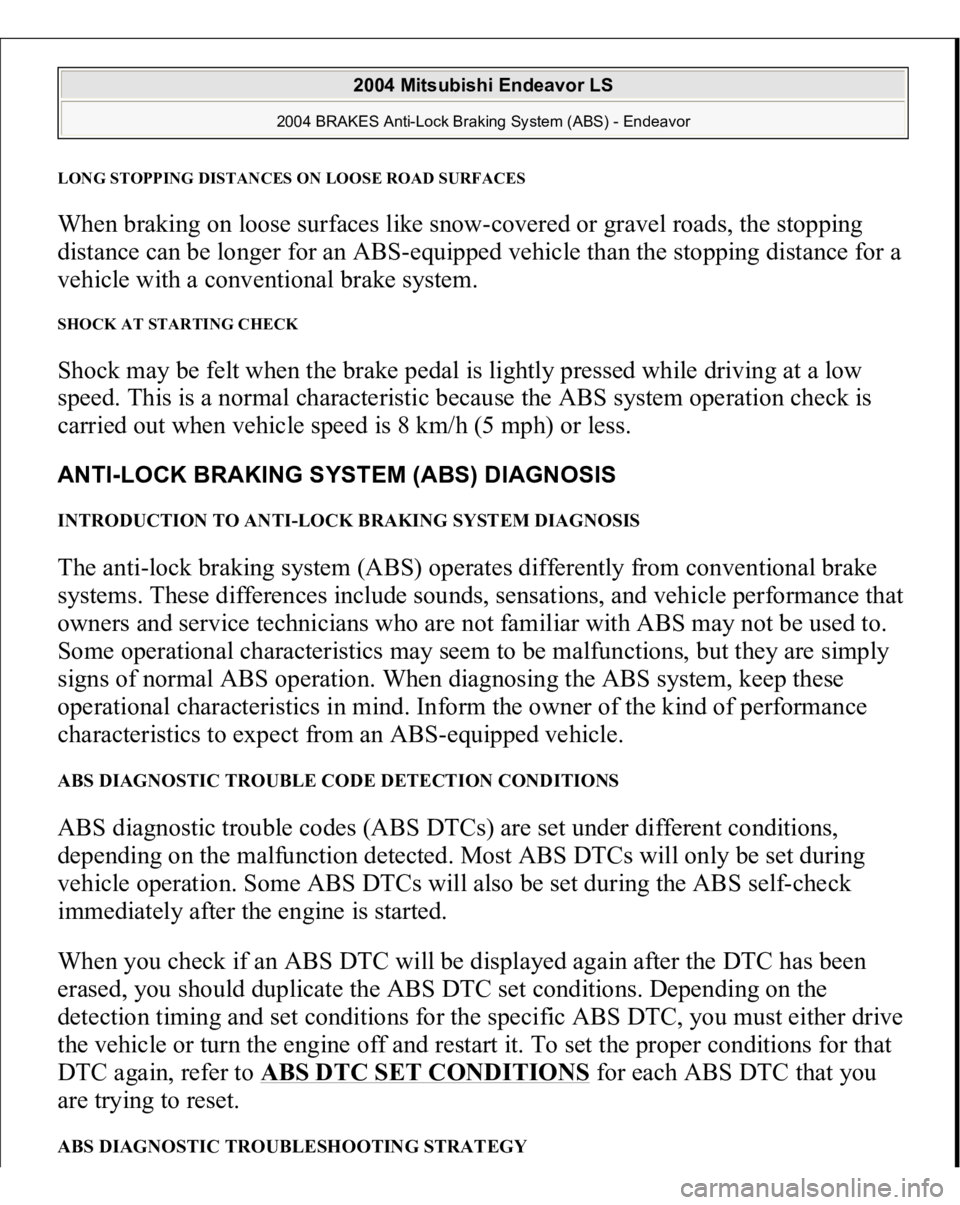
LONG STOPPING DISTANCES ON LOOSE ROAD SURFACESWhen braking on loose surfaces like snow-covered or gravel roads, the stopping
distance can be longer for an ABS-equipped vehicle than the stopping distance for a
vehicle with a conventional brake system. SHOCK AT STARTING CHECK Shock may be felt when the brake pedal is lightly pressed while driving at a low
speed. This is a normal characteristic because the ABS system operation check is
carried out when vehicle speed is 8 km/h (5 mph) or less. ANTI-LOCK BRAKING SYSTEM (ABS) DIAGNOSIS INTRODUCTION TO ANTI-LOCK BRAKING SYSTEM DIAGNOSIS The anti-lock braking system (ABS) operates differently from conventional brake
systems. These differences include sounds, sensations, and vehicle performance that
owners and service technicians who are not familiar with ABS may not be used to.
Some operational characteristics may seem to be malfunctions, but they are simply
signs of normal ABS operation. When diagnosing the ABS system, keep these
operational characteristics in mind. Inform the owner of the kind of performance
characteristics to expect from an ABS-equipped vehicle. ABS DIAGNOSTIC TROUBLE CODE DETECTION CONDITIONS ABS diagnostic trouble codes (ABS DTCs) are set under different conditions,
depending on the malfunction detected. Most ABS DTCs will only be set during
vehicle operation. Some ABS DTCs will also be set during the ABS self-check
immediately after the engine is started.
When you check if an ABS DTC will be displayed again after the DTC has been
erased, you should duplicate the ABS DTC set conditions. Depending on the
detection timing and set conditions for the specific ABS DTC, you must either drive
the vehicle or turn the engine off and restart it. To set the proper conditions for that
DTC again, refer to ABS DTC SET CONDITIONS
for each ABS DTC that you
are trying to reset.
ABS DIAGNOSTIC TROUBLESHOOTING STRATEGY
2004 Mitsubishi Endeavor LS
2004 BRAKES Anti-Lock Braking System (ABS) - Endeavor
Page 276 of 3870

Observe these precautions when servicing the air bag system:
Disable SRS before servicing any SRS component. Failure to do this may
result in accidental air bag deployment and possible personal injury. See DISABLING & ACTIVATING AIR BAG SYSTEM
.
After disabling SRS, wait at least 60 seconds before servicing SRS. After servicing, always turn ignition on from outside of vehicle in case of
accidental air bag module deployment. After servicing, check AIR BAG warning light to verify system operation. See SYSTEM OPERATION CHECK
.
Always wear safety glasses when servicing or handling an SRS component. Hearing protection must be worn when performing deployment procedures. DO NOT expose air bag modules, clockspring or SRS ECU to temperatures
greater than 200°F (93°C ). DO NOT expose seat belt pretensioners to temperatures greater than 194°F
(90°C ). When placing a live air bag module on a bench or other surface, always place
air bag module with trim cover facing up and away from surface. This will
reduce motion of air bag module if accidental deployment occurs. After air bag module deploys, surrounding surfaces may contain deposits of
sodium hydroxide, which irritates skin. Always wear safety glasses, rubber
gloves and a long-sleeved shirt during clean-up. Wash hands using mild soap
and water. Follow correct clean-up and disposal procedures. See
DISPOSAL
PROCEDURES
.
Because of critical system operating requirements, DO NOT service any SRS
components. Repairs are only made by replacing defective components. DO NOT allow any electrical source near inflator on back of air bag module. When carrying a live (undeployed) air bag module, trim cover must be pointed
away from body to minimize injury in case of accidental air bag deployment. If instructed to probe wire harness, do so from harness side of connector. DO NOT probe a wire through insulator. Wire will be damaged and eventually
fail due to corrosion. When
performin
g electrical tests,
prevent accidental shortin
g of terminals.
2004 Mitsubishi Endeavor Limited
2004 ACCESSORIES/SAFETY EQUIPMENT Mitsubishi - Air Bag Restraint Systems
Page 278 of 3870
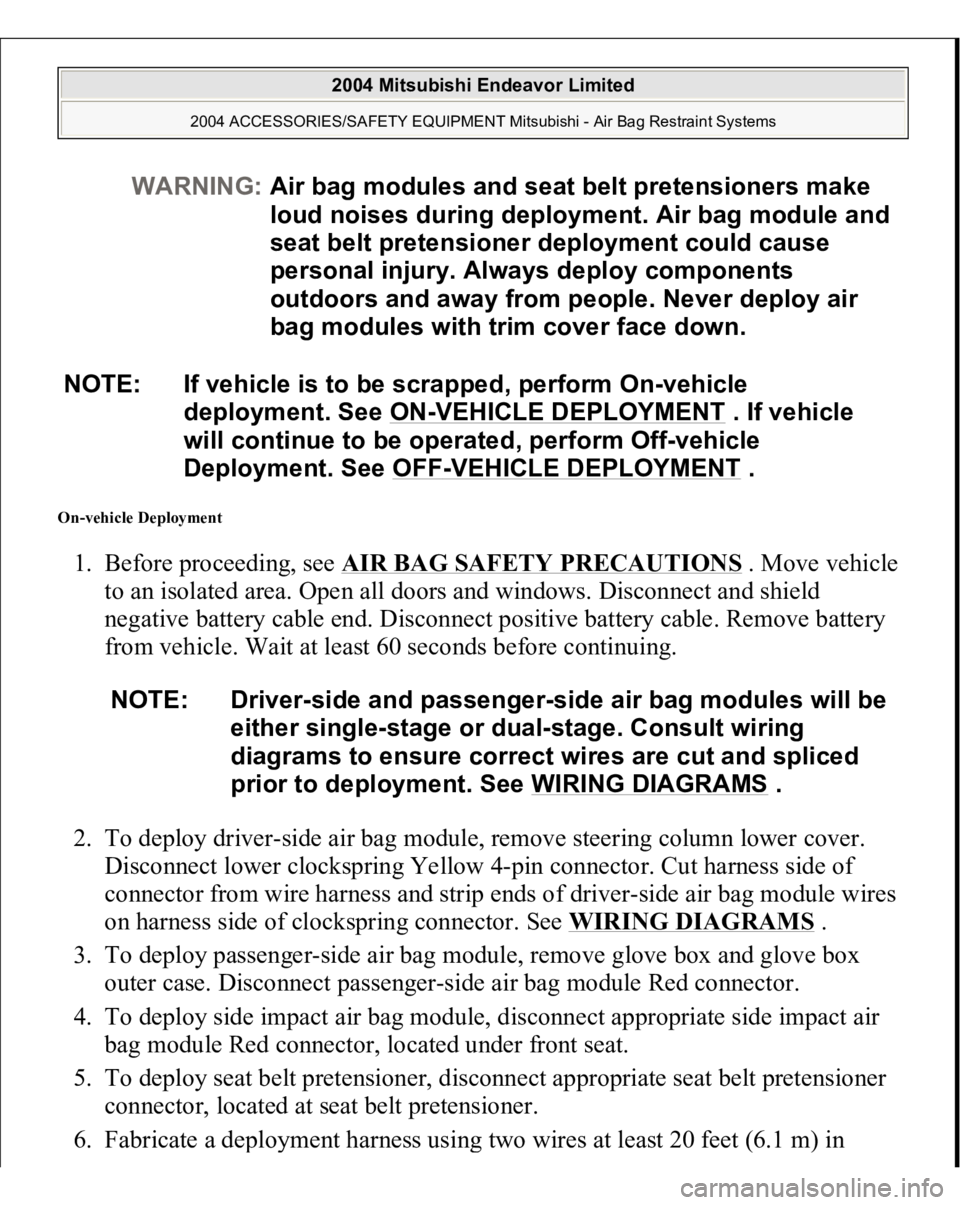
On-vehicle Deployment 1. Before proceeding, see
AIR BAG SAFETY PRECAUTIONS
. Move vehicle
to an isolated area. Open all doors and windows. Disconnect and shield
negative battery cable end. Disconnect positive battery cable. Remove battery
from vehicle. Wait at least 60 seconds before continuing.
2. To deploy driver-side air bag module, remove steering column lower cover.
Disconnect lower clockspring Yellow 4-pin connector. Cut harness side of
connector from wire harness and strip ends of driver-side air bag module wires
on harness side of clockspring connector. See
WIRING DIAGRAMS
.
3. To deploy passenger-side air bag module, remove glove box and glove box
outer case. Disconnect passenger-side air bag module Red connector.
4. To deploy side impact air bag module, disconnect appropriate side impact air
bag module Red connector, located under front seat.
5. To deploy seat belt pretensioner, disconnect appropriate seat belt pretensioner
connector, located at seat belt pretensioner.
6. Fabricate a de
ployment harness usin
g two wires at least 20 feet
(6.1 m
) in
WARNING:Air bag modules and seat belt pretensioners make
loud noises during deployment. Air bag module and
seat belt pretensioner deployment could cause
personal injury. Always deploy components
outdoors and away from people. Never deploy air
bag modules with trim cover face down.
NOTE: If vehicle is to be scrapped, perform On-vehicle
deployment. See ON
-VEHICLE DEPLOYMENT
. If vehicle
will continue to be operated, perform Off-vehicle
Deployment. See OFF
-VEHICLE DEPLOYMENT
.
NOTE: Driver-side and passenger-side air bag modules will be
either single-stage or dual-stage. Consult wiring
diagrams to ensure correct wires are cut and spliced
prior to deployment. See WIRING DIAGRAMS
.
2004 Mitsubishi Endeavor Limited
2004 ACCESSORIES/SAFETY EQUIPMENT Mitsubishi - Air Bag Restraint Systems
Page 279 of 3870
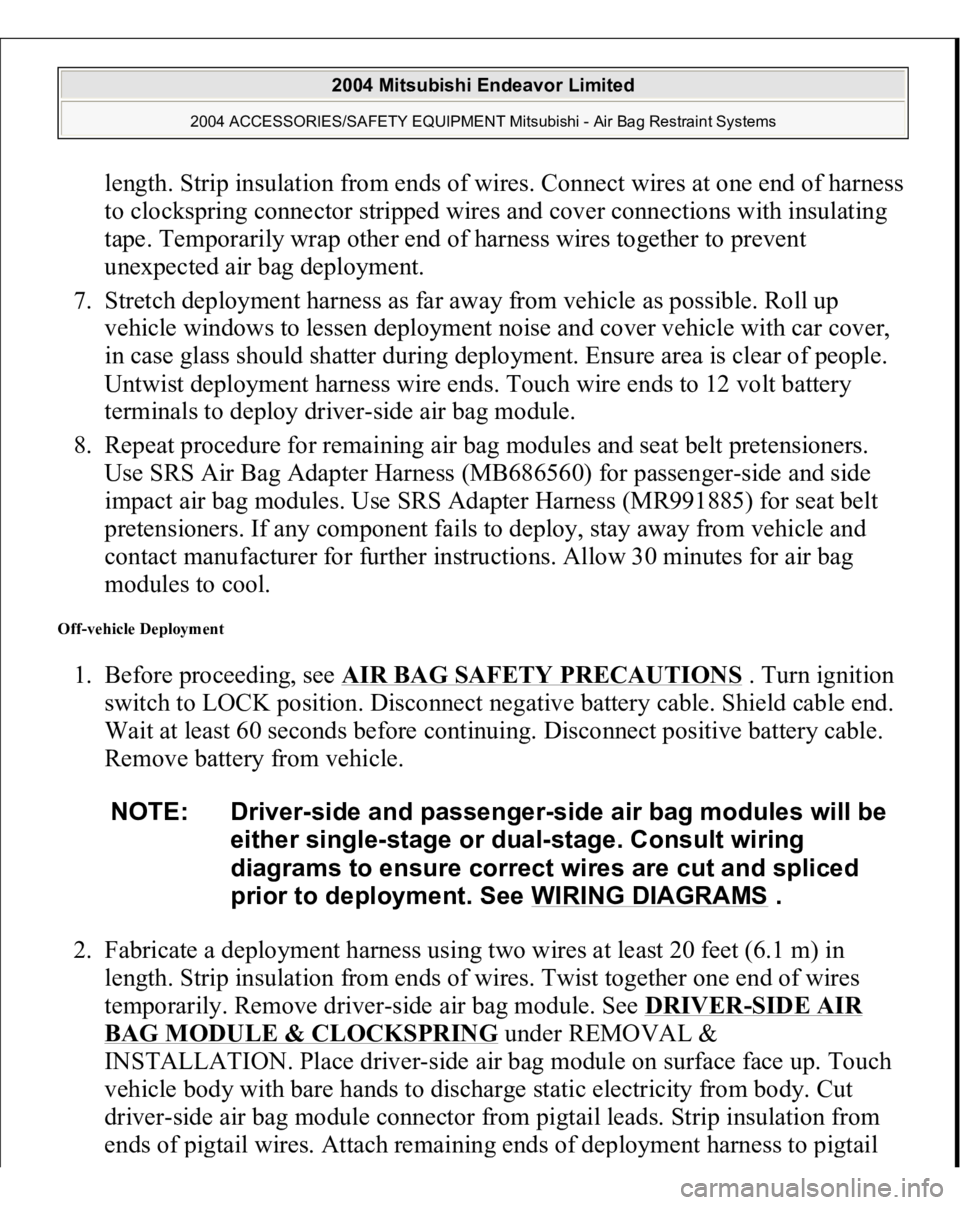
length. Strip insulation from ends of wires. Connect wires at one end of harness
to clockspring connector stripped wires and cover connections with insulating
tape. Temporarily wrap other end of harness wires together to prevent
unexpected air bag deployment.
7. Stretch deployment harness as far away from vehicle as possible. Roll up
vehicle windows to lessen deployment noise and cover vehicle with car cover,
in case glass should shatter during deployment. Ensure area is clear of people.
Untwist deployment harness wire ends. Touch wire ends to 12 volt battery
terminals to deploy driver-side air bag module.
8. Repeat procedure for remaining air bag modules and seat belt pretensioners.
Use SRS Air Bag Adapter Harness (MB686560) for passenger-side and side
impact air bag modules. Use SRS Adapter Harness (MR991885) for seat belt
pretensioners. If any component fails to deploy, stay away from vehicle and
contact manufacturer for further instructions. Allow 30 minutes for air bag
modules to cool.
Off-vehicle Deployment 1. Before proceeding, see
AIR BAG SAFETY PRECAUTIONS
. Turn ignition
switch to LOCK position. Disconnect negative battery cable. Shield cable end.
Wait at least 60 seconds before continuing. Disconnect positive battery cable.
Remove battery from vehicle.
2. Fabricate a deployment harness using two wires at least 20 feet (6.1 m) in
length. Strip insulation from ends of wires. Twist together one end of wires
temporarily. Remove driver-side air bag module. See
DRIVER
-SIDE AIR
BAG MODULE & CLOCKSPRING
under REMOVAL &
INSTALLATION. Place driver-side air bag module on surface face up. Touch
vehicle body with bare hands to discharge static electricity from body. Cut
driver-side air bag module connector from pigtail leads. Strip insulation from
ends of
pigtail wires. Attach remainin
g ends of de
ployment harness to
pigtail NOTE: Driver-side and passenger-side air bag modules will be
either single-stage or dual-stage. Consult wiring
diagrams to ensure correct wires are cut and spliced
prior to deployment. See WIRING DIAGRAMS
.
2004 Mitsubishi Endeavor Limited
2004 ACCESSORIES/SAFETY EQUIPMENT Mitsubishi - Air Bag Restraint Systems
Page 280 of 3870
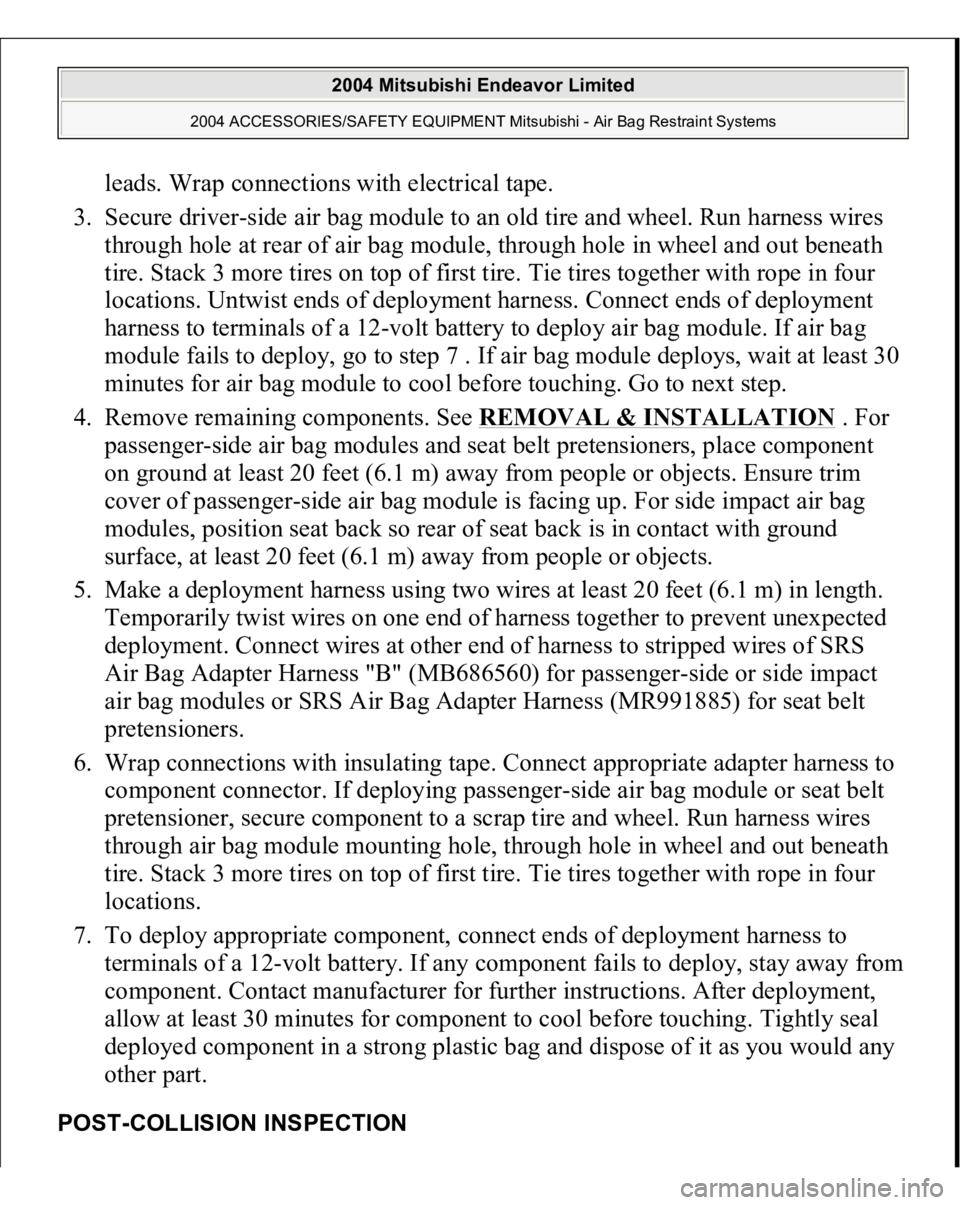
leads. Wrap connections with electrical tape.
3. Secure driver-side air bag module to an old tire and wheel. Run harness wires
through hole at rear of air bag module, through hole in wheel and out beneath
tire. Stack 3 more tires on top of first tire. Tie tires together with rope in four
locations. Untwist ends of deployment harness. Connect ends of deployment
harness to terminals of a 12-volt battery to deploy air bag module. If air bag
module fails to deploy, go to step 7 . If air bag module deploys, wait at least 30
minutes for air bag module to cool before touching. Go to next step.
4. Remove remaining components. See
REMOVAL & INSTALLATION
. For
passenger-side air bag modules and seat belt pretensioners, place component
on ground at least 20 feet (6.1 m) away from people or objects. Ensure trim
cover of passenger-side air bag module is facing up. For side impact air bag
modules, position seat back so rear of seat back is in contact with ground
surface, at least 20 feet (6.1 m) away from people or objects.
5. Make a deployment harness using two wires at least 20 feet (6.1 m) in length.
Temporarily twist wires on one end of harness together to prevent unexpected
deployment. Connect wires at other end of harness to stripped wires of SRS
Air Bag Adapter Harness "B" (MB686560) for passenger-side or side impact
air bag modules or SRS Air Bag Adapter Harness (MR991885) for seat belt
pretensioners.
6. Wrap connections with insulating tape. Connect appropriate adapter harness to
component connector. If deploying passenger-side air bag module or seat belt
pretensioner, secure component to a scrap tire and wheel. Run harness wires
through air bag module mounting hole, through hole in wheel and out beneath
tire. Stack 3 more tires on top of first tire. Tie tires together with rope in four
locations.
7. To deploy appropriate component, connect ends of deployment harness to
terminals of a 12-volt battery. If any component fails to deploy, stay away from
component. Contact manufacturer for further instructions. After deployment,
allow at least 30 minutes for component to cool before touching. Tightly seal
deployed component in a strong plastic bag and dispose of it as you would any
other part.
POST
-COLLISION INSPECTION
2004 Mitsubishi Endeavor Limited
2004 ACCESSORIES/SAFETY EQUIPMENT Mitsubishi - Air Bag Restraint Systems
Page 281 of 3870

When a vehicle has been involved in a collision, certain components of the passive
restraint system must be inspected or replaced. See
AIR BAG/SRS
COMPONENT INSPECTION & REPLACEMENT TABLES
article in the
GENERAL INFORMATION section.
REMOVAL & INSTALLATION DRIVER-SIDE AIR BAG MODULE & CLOCKSPRING Removal & Installation (With Single-stage AIR Bag System) 1. Before proceeding, see
AIR BAG SAFETY PRECAUTIONS
. Ensure front
wheels are in straight-ahead position. Turn ignition off. Disable air bag system.
See
DISABLING & ACTIVATING AIR BAG SYSTEM
.
2. Remove lower cover from steering wheel. Remove driver-side air bag module
bolts from rear of steering wheel. Remove driver-side air bag module. See
Fig.
3 . Remove damper weight from steering wheel. Remove steering wheel nut
and discard. Using Steering Wheel Puller (MB990803), remove steering wheel.
3. Remove upper and lower steering column covers. Disconnect clockspring
electrical connectors. Remove clockspring screws. Remove clockspring from
steering column.
4. To install, reverse removal procedure. If necessary, center clockspring. See CENTERING CLOCKSPRING
under ADJUSTMENTS. Tighten
clockspring screws, NEW steering wheel nut and driver-side air bag module
bolts to specification. See
TORQUE SPECIFICATIONS
. Activate air bag
s
ystem. WARNING:Accidental air bag deployment is possible. Personal
injury may result. Read and follow all WARNINGS
and AIR BAG SAFETY PRECAUTIONS
before
working on air bag system or related components.
2004 Mitsubishi Endeavor Limited
2004 ACCESSORIES/SAFETY EQUIPMENT Mitsubishi - Air Bag Restraint Systems
Page 282 of 3870
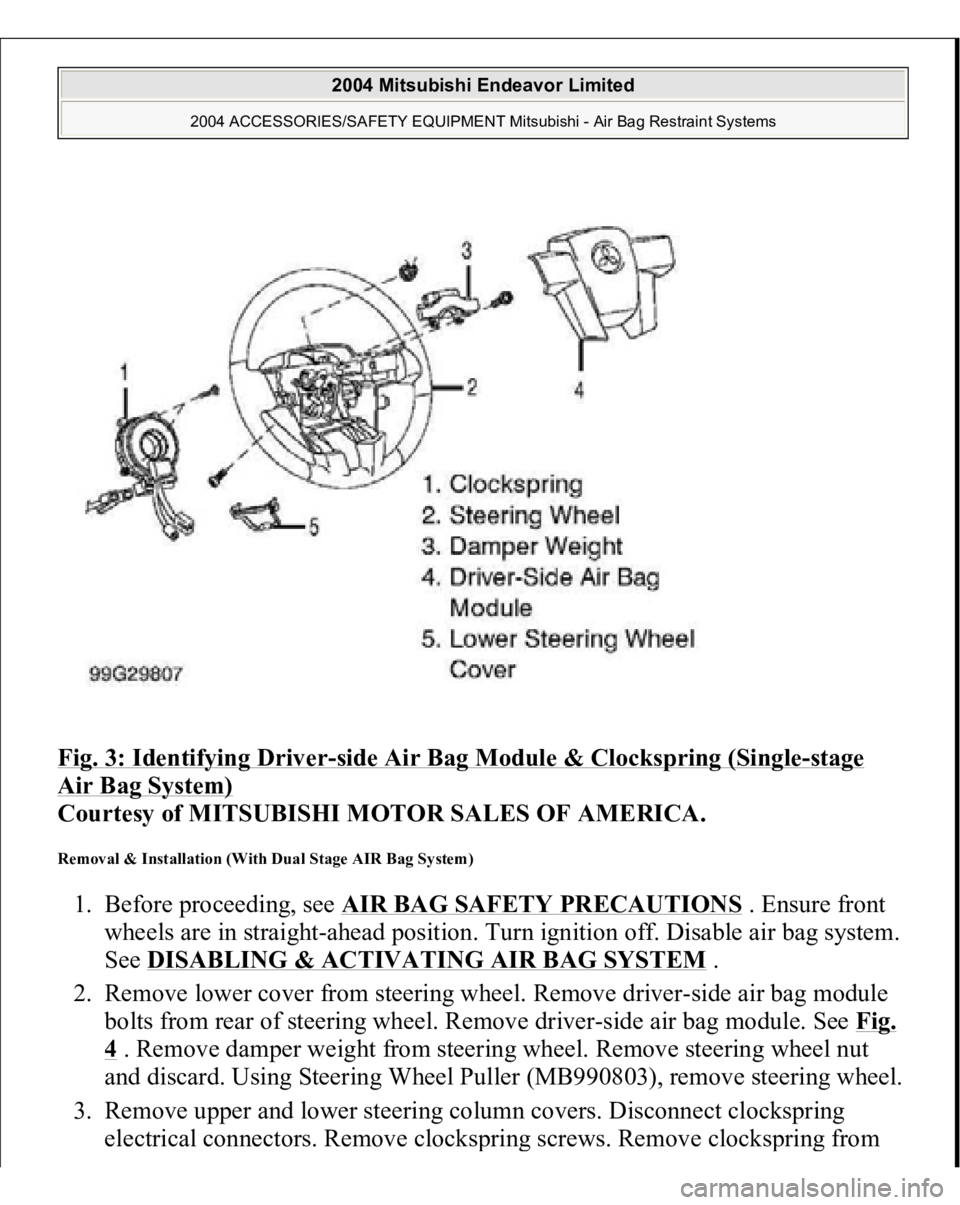
Fig. 3: Identifying Driver
-side Air Bag Module & Clockspring (Single
-stage
Air Bag System)
Courtesy of MITSUBISHI MOTOR SALES OF AMERICA.
Removal & Installation (With Dual Stage AIR Bag System) 1. Before proceeding, see
AIR BAG SAFETY PRECAUTIONS
. Ensure front
wheels are in straight-ahead position. Turn ignition off. Disable air bag system.
See
DISABLING & ACTIVATING AIR BAG SYSTEM
.
2. Remove lower cover from steering wheel. Remove driver-side air bag module
bolts from rear of steering wheel. Remove driver-side air bag module. See Fig.
4 . Remove damper weight from steering wheel. Remove steering wheel nut
and discard. Using Steering Wheel Puller (MB990803), remove steering wheel.
3. Remove upper and lower steering column covers. Disconnect clockspring
electrical connectors. Remove clocks
prin
g screws. Remove clocks
prin
g from
2004 Mitsubishi Endeavor Limited
2004 ACCESSORIES/SAFETY EQUIPMENT Mitsubishi - Air Bag Restraint Systems
Page 283 of 3870

steering column.
4. To install, reverse removal procedure. If necessary, center clockspring. See
CENTERING CLOCKSPRING
under ADJUSTMENTS. Tighten
clockspring screws, NEW steering wheel nut and driver-side air bag module
bolts to specification. See TORQUE SPECIFICATIONS
. Activate air bag
system.
Fig. 4: Identifying Driver
-side Air Bag Module & Clockspring (Dual
-stage Air
Bag System)
Courtesy of MITSUBISHI MOTOR SALES OF AMERICA.
FLOOR CONSOLE ASSEMBLY (WITH DUAL STAGE AIR BAG SYSTEM) Removal & Installation 1. Before proceeding, see AIR BAG SAFETY PRECAUTIONS
. Disable air
bag system. See DISABLING & ACTIVATING AIR BAG SYSTEM
.
2. Remove inner box tray. See Fig. 5
. Remove plate. Remove cup holder,
Remove left and right side covers. Remove gearshift lever panel. Remove
accessory panel. Remove rear A/C switch and accessory socket. Remove floor
console assembl
y.
2004 Mitsubishi Endeavor Limited
2004 ACCESSORIES/SAFETY EQUIPMENT Mitsubishi - Air Bag Restraint Systems